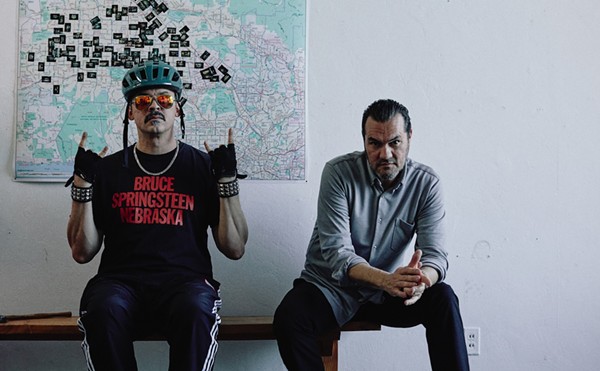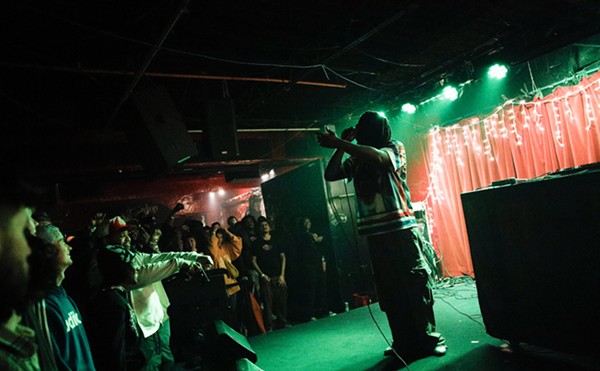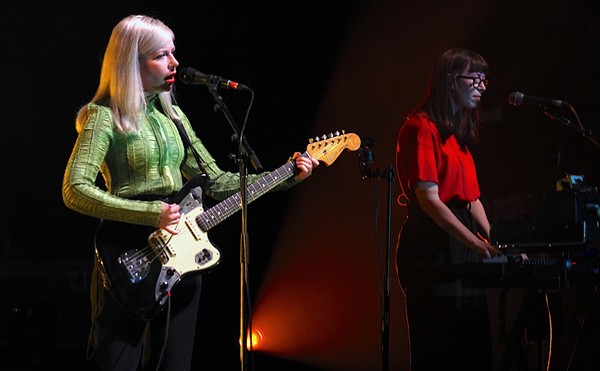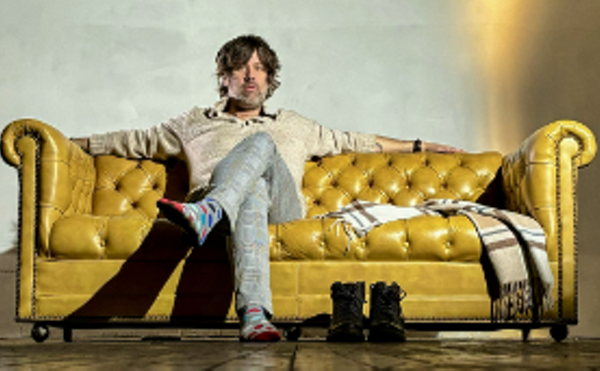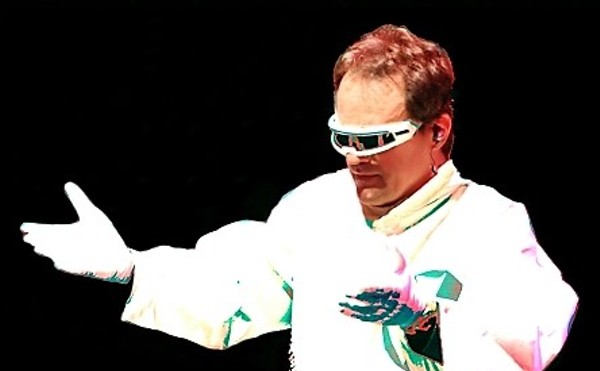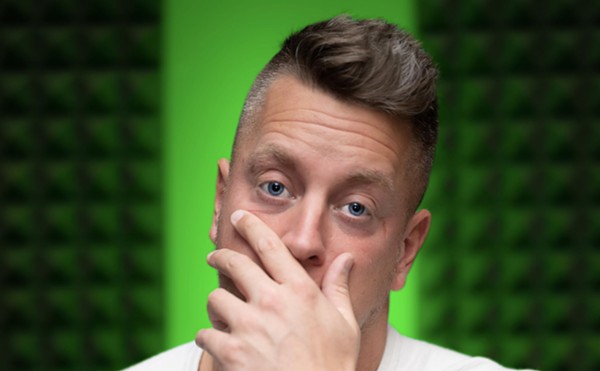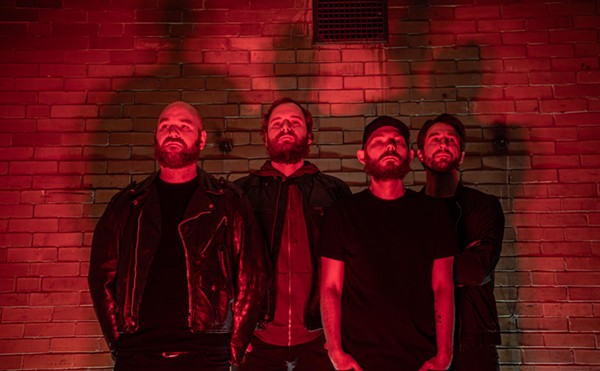Pop Star Kiesza to Make Cleveland Debut Next Week at House of Blues
Concert Preview
By Jeff Niesel on Fri, Apr 24, 2015 at 10:50 am
[
{
"name": "Ad - NativeInline - Injected",
"component": "38482495",
"insertPoint": "3",
"requiredCountToDisplay": "5"
},{
"name": "Real 1 Player (r2) - Inline",
"component": "38482494",
"insertPoint": "2/3",
"requiredCountToDisplay": "9"
}
]
Kiesa “Kiesza” Rae Ellestad originally set out to become a sailor. That’s right, the mega pop star whose electronic dance music hit “Hideaway” — with a Chicago house beat and upper-register vocals, the song sounds like a mash-up of Ray of Light-era Madonna and Adele — lays claim to more than 202 million combined YouTube views and over 100 million worldwide streams on Spotify, initially joined the navy. Born in Calgary, she enlisted in the reserves when she was very young.
“I was 16 turning 17,”she says via Skype. “I was too young but they let me into boot camp because I was turning 17. I trained and boarded in Ontario and then was a bit of training in Victoria. I did most of my time in Calgary.”
Kiesza, who says she’s always been “very musical” and initially learned to play piano, also picked up the guitar while she was in the naval reserves. The switch to guitar was out of necessity — after all, you're not likely to find a piano on board a naval vessel.
“When I started sailing, people would bring guitars because they were portable instruments,” she says. “They would jam on the deck. I came from a background where you didn’t jam. You played what was in front of you. I thought that was so cool. I started songwriting the minute I started playing guitar. With the first chord I strummed, I had a melody idea.”
From there, she never looked back. And to hear her tell it, she’s never had trouble writing tunes.
“I’ve never been without a melody in my head,” she says. “I’ve never had writer’s block. Sometimes, you struggle to find a chorus, but it’s been free flowing since the moment I started. I had a real sense of purpose since it came so effortlessly. I had to work and grow and learn more about songwriting. It’s never been something I struggled with.”
She initially began playing folk music while she was studying at Selkirk College in British Columbia.
“I started on a soft classical guitar,” she says. “I didn’t know how to play it. My first songs were slow and soft and almost lullaby-esque. As I got better, my music evolved with my level of playing. I decided to approach the piano as a songwriting tool. I wanted to play simple chords and create all these different melodies.”
But when she started music school at Berklee College of Music, she was “immersed in these music classes that teach you the history of rock and jazz and everything.” It left a huge impression on her.
“I was suddenly learning about music and surrounded by all different genres,” she says. “I started experimenting and trying different things out. I tried a jazz band and I even tried death metal for a short period of time. It was not easy on the voice.”
She initially thought of herself as a singer-songwriter until she met producer and collaborator Rami Samir Afuni, who worked on the Miley Cyrus album Bangerz as a composer, engineer and executive producer. He encouraged her to become a “commercial songwriter.”
“Rami was a graduate of Berklee and was working in the commercial writing industry,” she says. “I started working with him and people who write pop music. He introduced me to that world. I dove into the pop writing. I knew I needed to write pop music. It was fun and I really got into it. At a certain point, it didn’t register with me personally as an artist. I learned how to write simple lyrics. I even started my own band. As much as I love writing for other people, coming from a folk background. Lyrically, there are more stories I wanted to tell. I stopped my own projects to focus on songwriting. It was when I stopped my own projects that things started to happen.”
One thing that “happened” was “Hideaway,” a song she wrote on a whim in 2013. With its soulful vocals, the love song became a dance club smash. The fact that it has a thumping bass beat and percolating synthesizers certainly helped it find its way into the clubs.
“‘Hideaway’ came out of nowhere,” she says. “I was just having fun. I can’t say it’s the deepest song ever. But it’s very instinctive and sincere. It’s true to my background. It just felt like me.”
She says it was one of the first songs that made her think she should be singing her own material.
“It wasn’t that I didn’t connect with the music I was writing [for other singers], but it was that I wasn’t seeing myself singing the songs I was writing,” she says. “I was writing with other people in mind. With ‘Hideaway,’ I literally could not think of anyone else singing it. I loved the way I sounded on it. I had a whole vision of who I could be as a performer.”
She had dabbled in dance and theater when she was younger. At one point, she even studied ballet. But a knee injury derailed those interests.
“I felt like it was a great opportunity with my dance background to bring that into the music,” she says of embracing electronic dance music. “For me, I lost my dancing world at the age of 15 when I got injured. It took years for my knees and hips to heal. It was this big void in my life. When I started putting dance back into my music, it filled this huge gap. I didn’t expect anyone to hear ‘Hideaway’ honestly. It was a Facebook friend thing and an underground thing. It totally took me by storm when it went viral.”
The choreography in the music video for “Hideaway” makes the clip stand out. In one long take, Kiesza walks down a city street, breaking into dance moves as a male dancer hoists her into the air. All the more impressive — she filmed the video with a busted rib.
“It amazes me that I broke my rib,” she says. “I can’t pinpoint the moment. In the rehearsal, I did feel pain in my rib and by the time I was done with the shoot, I felt it swelling up. Two days after, I was bed-ridden. It was a hairline fracture. Man, it was painful. It still bothers me, but it was worth it.”
While dance music usually privileges beats over vocals, Kiesza’s music does the opposite. It seems to privilege vocals over the music, especially on a song like "Bad Thing" that features a sharp snare drum and little in the way of other instrumentation.
“That was something that Rami and I thought about,” she says when asked about putting her vocals up front in the sound mix. “Dance music is a DJ-driven or producer-driven thing. If you go back to classic songs like ‘What Is Love’ or even ‘Rhythm of the Night,’ it wasn’t about the singing. Even though her name wasn’t on the song, [‘Rhythm of the Night’] was about Corona’s vocals. There was more of a balance. I love that aspect. In this world of DJ-driven dance music, I thought it was a great time to bring back artist-driven dance music. It is about the producer, but it’s also about the singer. You’ll hear some of these great songs featuring an artist who might have even written it and sung it and they rarely get any credit. It’s so weird to me. They did all this work but didn’t get the credit. It also naturally happens because I am a singer. It just happens. It’s not something I think about too much. I just let my instincts drive the process.”
Back in September, she made her daytime television debut on Ellen. Earlier this year, she was asked to be on the show again.
“I love Ellen,” she says. “I had to cancel my rehearsals for my tour as a result. I had to do the tour on the fly and figure everything out on road. It was for Ellen’s birthday. I had to be there. She’s been so supportive of my career. She’s been such a huge fan. She has such positive energy. I didn’t want to miss out on that. We made it work.”
Touring in support of her new album Sound of a Woman, Kiesza makes her Cleveland debut at House of Blues. She’s also working on several collaborations. She’ll appear on the forthcoming Duran Duran album and she's even given her followup album some thought.
“I started jotting down ideas and got into the studio for a day,” she says. “Once the tour finishes, I’ll settle into the writing process. I do have an idea where I’m going to take it. It’s going to be different but not too far removed. It will be progression from this album.”
Kiesza, Betty Who, 8 p.m. Thursday, April 30, House of Blues, 308 Euclid Ave., 216-523-2583. Tickets: $20 ADV, $25 DOS, houseofblues.com.
“I was 16 turning 17,”she says via Skype. “I was too young but they let me into boot camp because I was turning 17. I trained and boarded in Ontario and then was a bit of training in Victoria. I did most of my time in Calgary.”
Kiesza, who says she’s always been “very musical” and initially learned to play piano, also picked up the guitar while she was in the naval reserves. The switch to guitar was out of necessity — after all, you're not likely to find a piano on board a naval vessel.
“When I started sailing, people would bring guitars because they were portable instruments,” she says. “They would jam on the deck. I came from a background where you didn’t jam. You played what was in front of you. I thought that was so cool. I started songwriting the minute I started playing guitar. With the first chord I strummed, I had a melody idea.”
From there, she never looked back. And to hear her tell it, she’s never had trouble writing tunes.
“I’ve never been without a melody in my head,” she says. “I’ve never had writer’s block. Sometimes, you struggle to find a chorus, but it’s been free flowing since the moment I started. I had a real sense of purpose since it came so effortlessly. I had to work and grow and learn more about songwriting. It’s never been something I struggled with.”
She initially began playing folk music while she was studying at Selkirk College in British Columbia.
“I started on a soft classical guitar,” she says. “I didn’t know how to play it. My first songs were slow and soft and almost lullaby-esque. As I got better, my music evolved with my level of playing. I decided to approach the piano as a songwriting tool. I wanted to play simple chords and create all these different melodies.”
But when she started music school at Berklee College of Music, she was “immersed in these music classes that teach you the history of rock and jazz and everything.” It left a huge impression on her.
“I was suddenly learning about music and surrounded by all different genres,” she says. “I started experimenting and trying different things out. I tried a jazz band and I even tried death metal for a short period of time. It was not easy on the voice.”
She initially thought of herself as a singer-songwriter until she met producer and collaborator Rami Samir Afuni, who worked on the Miley Cyrus album Bangerz as a composer, engineer and executive producer. He encouraged her to become a “commercial songwriter.”
“Rami was a graduate of Berklee and was working in the commercial writing industry,” she says. “I started working with him and people who write pop music. He introduced me to that world. I dove into the pop writing. I knew I needed to write pop music. It was fun and I really got into it. At a certain point, it didn’t register with me personally as an artist. I learned how to write simple lyrics. I even started my own band. As much as I love writing for other people, coming from a folk background. Lyrically, there are more stories I wanted to tell. I stopped my own projects to focus on songwriting. It was when I stopped my own projects that things started to happen.”
One thing that “happened” was “Hideaway,” a song she wrote on a whim in 2013. With its soulful vocals, the love song became a dance club smash. The fact that it has a thumping bass beat and percolating synthesizers certainly helped it find its way into the clubs.
“‘Hideaway’ came out of nowhere,” she says. “I was just having fun. I can’t say it’s the deepest song ever. But it’s very instinctive and sincere. It’s true to my background. It just felt like me.”
She says it was one of the first songs that made her think she should be singing her own material.
“It wasn’t that I didn’t connect with the music I was writing [for other singers], but it was that I wasn’t seeing myself singing the songs I was writing,” she says. “I was writing with other people in mind. With ‘Hideaway,’ I literally could not think of anyone else singing it. I loved the way I sounded on it. I had a whole vision of who I could be as a performer.”
She had dabbled in dance and theater when she was younger. At one point, she even studied ballet. But a knee injury derailed those interests.
“I felt like it was a great opportunity with my dance background to bring that into the music,” she says of embracing electronic dance music. “For me, I lost my dancing world at the age of 15 when I got injured. It took years for my knees and hips to heal. It was this big void in my life. When I started putting dance back into my music, it filled this huge gap. I didn’t expect anyone to hear ‘Hideaway’ honestly. It was a Facebook friend thing and an underground thing. It totally took me by storm when it went viral.”
The choreography in the music video for “Hideaway” makes the clip stand out. In one long take, Kiesza walks down a city street, breaking into dance moves as a male dancer hoists her into the air. All the more impressive — she filmed the video with a busted rib.
“It amazes me that I broke my rib,” she says. “I can’t pinpoint the moment. In the rehearsal, I did feel pain in my rib and by the time I was done with the shoot, I felt it swelling up. Two days after, I was bed-ridden. It was a hairline fracture. Man, it was painful. It still bothers me, but it was worth it.”
While dance music usually privileges beats over vocals, Kiesza’s music does the opposite. It seems to privilege vocals over the music, especially on a song like "Bad Thing" that features a sharp snare drum and little in the way of other instrumentation.
“That was something that Rami and I thought about,” she says when asked about putting her vocals up front in the sound mix. “Dance music is a DJ-driven or producer-driven thing. If you go back to classic songs like ‘What Is Love’ or even ‘Rhythm of the Night,’ it wasn’t about the singing. Even though her name wasn’t on the song, [‘Rhythm of the Night’] was about Corona’s vocals. There was more of a balance. I love that aspect. In this world of DJ-driven dance music, I thought it was a great time to bring back artist-driven dance music. It is about the producer, but it’s also about the singer. You’ll hear some of these great songs featuring an artist who might have even written it and sung it and they rarely get any credit. It’s so weird to me. They did all this work but didn’t get the credit. It also naturally happens because I am a singer. It just happens. It’s not something I think about too much. I just let my instincts drive the process.”
Back in September, she made her daytime television debut on Ellen. Earlier this year, she was asked to be on the show again.
“I love Ellen,” she says. “I had to cancel my rehearsals for my tour as a result. I had to do the tour on the fly and figure everything out on road. It was for Ellen’s birthday. I had to be there. She’s been so supportive of my career. She’s been such a huge fan. She has such positive energy. I didn’t want to miss out on that. We made it work.”
Touring in support of her new album Sound of a Woman, Kiesza makes her Cleveland debut at House of Blues. She’s also working on several collaborations. She’ll appear on the forthcoming Duran Duran album and she's even given her followup album some thought.
“I started jotting down ideas and got into the studio for a day,” she says. “Once the tour finishes, I’ll settle into the writing process. I do have an idea where I’m going to take it. It’s going to be different but not too far removed. It will be progression from this album.”
Kiesza, Betty Who, 8 p.m. Thursday, April 30, House of Blues, 308 Euclid Ave., 216-523-2583. Tickets: $20 ADV, $25 DOS, houseofblues.com.
Tags:
SCENE Supporters make it possible to tell the Cleveland stories you won’t find elsewhere.
Become a supporter today.
About The Author
Jeff Niesel
Jeff has been covering the Cleveland music scene for more than 20 years now. And on a regular basis, he tries to talk to whatever big acts are coming through town, too. If you're in a band that he needs to hear, email him at [email protected].
Scroll to read more Music News articles
Newsletters
Join Cleveland Scene Newsletters
Subscribe now to get the latest news delivered right to your inbox.




